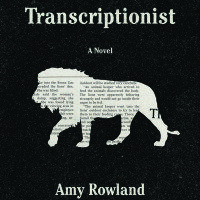The ideal reader for Amy Rowland’s The Transcriptionist is stranded in public, waiting. I don’t mean to suggest that this novel is light, or lacks rigor, but simply that distraction—people milling about, talking, laughing, shouting—accents this book like music. Myself, I read The Transcriptionist while waiting at National Tire & Battery for car repairs, while flying home for a visit, and while sitting on a bench in Houston’s busiest mall. In each case, the ambient noise fused with the novel, embedding me in a state of mind similar to the protagonist’s, and creating a more powerful experience than I would’ve had reading at home in silence.
The titular transcriptionist (“or, in the perplexing vocabulary of the corporate world, Recording Room operator”) is Lena Respass, a thirty-three-year-old living in Manhattan at a Salvation Army residence (her shower has handrails in it). She works as the (only) transcriptionist for an unnamed but mighty newspaper, spending her workdays with a headset and a Dictaphone in an otherwise empty room. She transcribes the voices of reporters—both urgent dispatches from warzones and indifferent puff pieces—and awakens each morning “with someone else’s words, someone else’s thoughts, ribboning around her brain.” At work, she rewinds her tapes and listens obsessively, trying to get the words right, trying to forge a clean transcript; Rowland calls her protagonist “a gatekeeper for background noise,” and I thought of Harry Caul (Gene Hackman’s character) in Francis Ford Coppola’s The Conversation, obsessing over a few unintelligible words of an audio recording.
The Transcriptionist is far from a brooding thriller, however. In some ways, it’s a novel about chance encounters, the most important of which happens when Lena meets an older, blind woman on the bus. This blind woman works as a court stenographer and tries to form a connection with Lena over the nature of transcription. “‘Voices coursing through our veins,’” the older woman tells the younger. “‘You can’t live that way forever, not people like us.’” Days later, a reporter asks Lena to transcribe a story about an unidentified woman who committed suicide by throwing herself to the lions at the Bronx Zoo—a woman whom Lena recognizes as the blind lady from the bus. Thus, Lena sets out to identify this woman, to find somebody to claim her body, and to discover what made her want another living creature to devour her.

This search forms the plot of The Transcriptionist, but it doesn’t convey the magic of this book, in which Rowland demonstrates a gift for making mystery out of a concrete style. Paul Harding has advised writers to write “as precisely and as lucidly and as richly” as they can about mysterious things, instead of writing with mystery and obscurity about clichés; much of The Transcriptionist would likely please him. Consider Rowland’s description of a blackout which has changed New York “into a strange and silent place, as if blanketed in black snow”; or consider the blind woman’s obituary, which has left her “a fragile skeleton of black ink on a bed of cheap pulp paper”; or consider a successful, arrogant journalist, who “gives the impression of a highly focused, structurally sophisticated, and quite expensive effort, like a skyscraper reinforced against the wind effect”: in each of these examples, Rowland shows her dexterity with language—her skill at nailing precisely what is mysterious about something or someone with originality, yet without preciousness.
Then there’s this remarkable passage, detailing Lena’s efforts to try and forget the words she transcribed earlier:
She closes her eyes tight, then opens them, but the words remain, creeping across the white ceiling. She cannot escape them. They unwind slowly like a parasitic worm, taking up more and more of her brain. It reminds her of African river blindness—which she had transcribed an article on last summer—when the nematode worm finds a host in the unsuspecting victim’s body and grows and grows until it needs more space and comes out through the eyes.
In other words, the only way Lena can describe the thing she’s trying to forget—i.e., transcription—is to evoke a metaphor from something she once transcribed. It’s slippery here, how Rowland moves from a personal, emotional tone into the scientific language still rattling around Lena’s brain—slippery, but also remarkable.
The Transcriptionist has its flaws—an end “twist” is a bit of a deus ex machina; the descriptions of Lena’s childhood favor obscurity when directness would’ve been better (the only place where Rowland makes this mistake)—but this novel succeeds in portraying material that feels at once retro (e.g., the tools of transcription and the ever-fading feasibility of a daily newspaper) and contemporary, especially as the newspaper owners, fearful of a terrorist attack, insert microchips into the photo IDs (“making it easier to identify bodies in the rubble”), and instruct the staff in how to use their new “escape hoods” (“People practice putting them on, and the room takes on the look of a hazmat convention”). Here and elsewhere, Lena is always preparing for tragedy—to weather it, or to record it. “Reporters aren’t moralists,” someone tells Lena; they are, instead, “guardians.” But Lena is a deeply moral character, and Rowland’s is a deeply moral novel that tells the story of a woman who wants badly to cease being objective—who, instead, wants the same subjective experiences we all enjoy when we aren’t forced to carry with us the words of strangers.




